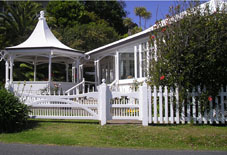
History
The first
European settlers were escaped prisoners or deserting
sailors but colonists and missionaries soon followed.
Captain Hansen, who brought Rev Samuel Marsden here on
his brig the
'Active' bought land
here in 1814.
Russell's waterfront is
where much of NZ's early history was
made. Fittingly for the "Hell-hole of the Pacific", as
Russell was labeled in its wild early days, the oldest
link is the Duke of Marlborough hotel. Its liquor license
dates to July 1840 granted then to a convict who had run
a grog shop since 1827. The actual building has been
destroyed three times. The present one was originally a
cable station (for the undersea international telegraphic
cable) and was relocated 100 km south from Cable Bay in
1931.
Alongside the
hotel is a huge Moreton Bay fig tree which survived the
fire that destroyed the third "Duke". It was planted by
the Collector of Customs who built and occupied the
Customs House next door in 1870, now the Police
Station.
At the north end of the beach is the beautifully restored
Cavalli House (pictured) built for fish factory managers
in 1889.
The old "General Store" beside the wharf was built in
1880 on the site where the harbourmaster previously had
office and home. Heading south, first is the Swordfish
Club (1924) for Bay of Islands gamefishing popularised by
American writer Zane Grey after the first recorded
swordfish was landed here in 1913.
Further south is 'The
Gables', parts of which date to 1847.
Now a restaurant, it has been a bakehouse, a Salvation
Army boys' home, a private hotel and a
residence. Some of the original piles were massive
whalebones.
Beside the Town Hall is an old cannon brought as ballast
on the 'Surabaya'
with some of the first horses from Chile in 1841. The
ship was reportedly scuttled in Matauwhi Bay but the
cannon defended Te Maiki against Hone Heke in 1845.
South past Hanunui Lodge, Tamati Waka Nene, a Maori
warrior who protected the missionaries, is commemorated
by a brick seat made from his chimney.
Nearby is an iron crane Samuel Stephenson used to unload
coastal shipping on his wharf. In 1880 it was moved to a
'new wharf' to
unload larger shipping. You can see the remains of the
'new wharf',
opposite the crane. In the 1920s the crane was welded to
lift gamefish for weighing - the joins
are still visible - and it was retired in 1972.
In a shelter outside the Museum is an old American
whaleboat. These were the main means of local transport
in the early days of settlement.
|